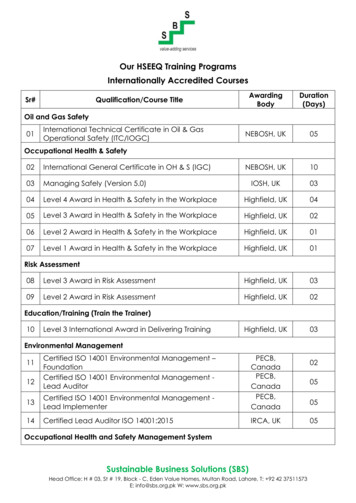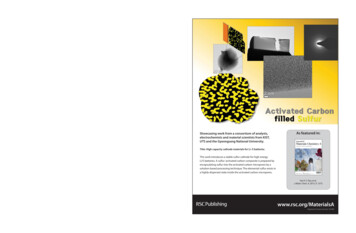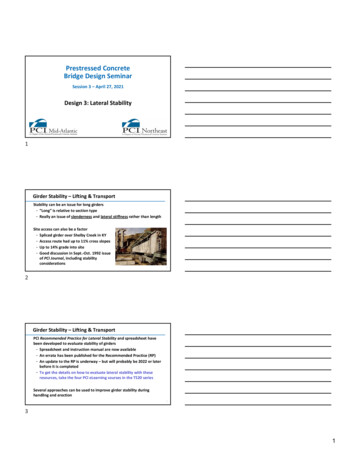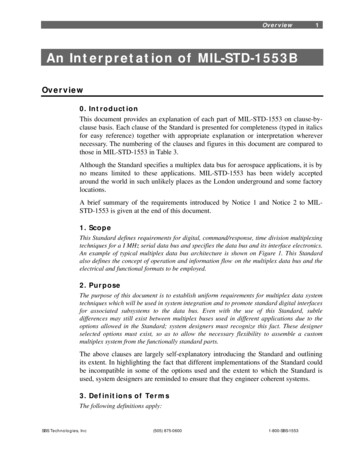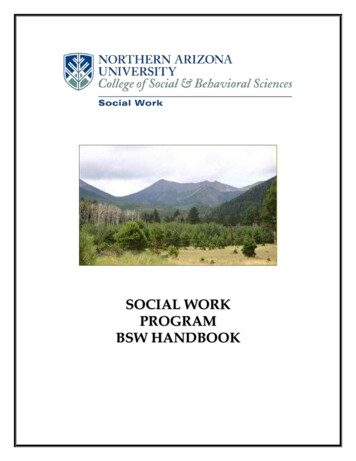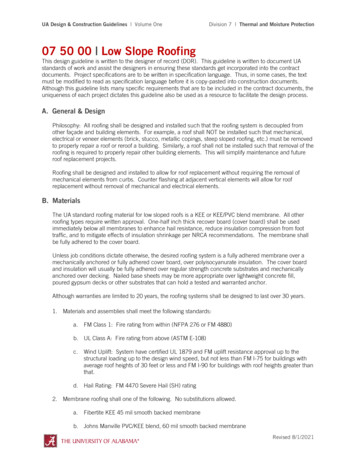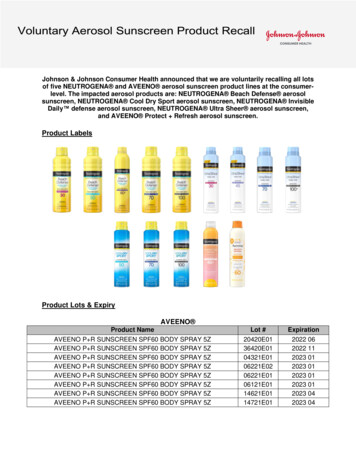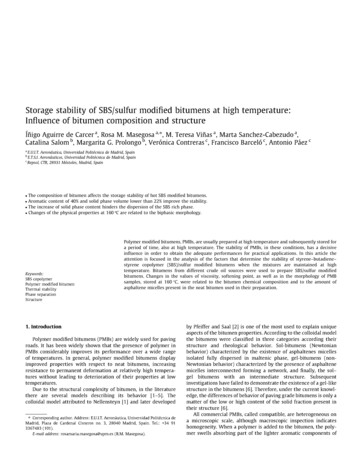
Transcription
Storage stability of SBS/sulfur modified bitumens at high temperature:Influence of bitumen composition and structureInigo Aguirre de Career3, Rosa M. Masegosa3'*, M. Teresa Vinas3, Marta Sanchez-Cabezudo3,Catalina Salom b, Margarita G. Prolongo b, Veronica Contrerasc, Francisco Barceloc, Antonio Paez'*E.U.I.T. Aeronautica, Universidad Politecnica de Madrid, SpainbE.T.S.I. Aeronauticos, Universidad Politecnica de Madrid, SpaincRepsol, CTR, 28931 Mostoles, Madrid, Spain The composition of bitumen affects the storage stability of hot SBS modified bitumens.Aromatic content of 40% and solid phase volume lower than 22% improve the stability.The increase of solid phase content hinders the dispersion of the SBS rich phase.Changes of the physical properties at 160 eC are related to the biphasic morphology.Keywords:SBS copolymerPolymer modified bitumenThermal stabilityPhase separationStructurePolymer modified bitumens, PMBs, are usually prepared at high temperature and subsequently stored fora period of time, also at high temperature. The stability of PMBs, in these conditions, has a decisiveinfluence in order to obtain the adequate performances for practical applications. In this article theattention is focused in the analysis of the factors that determine the stability of styrene-butadienestyrene copolymer (SBS)/sulfur modified bitumens when the mixtures are maintained at hightemperature. Bitumens from different crude oil sources were used to prepare SBS/sulfur modifiedbitumens. Changes in the values of viscosity, softening point, as well as in the morphology of PMBsamples, stored at 160 C, were related to the bitumen chemical composition and to the amount ofasphaltene micelles present in the neat bitumen used in their preparation.1. IntroductionPolymer modified bitumens (PMBs) are widely used for pavingroads. It has been widely shown that the presence of polymer inPMBs considerably improves its performance over a wide rangeof temperatures. In general, polymer modified bitumens displayimproved properties with respect to neat bitumens, increasingresistance to permanent deformation at relatively high temperatures without leading to deterioration of their properties at lowtemperatures.Due to t h e structural complexity of bitumen, in t h e literaturethere are several models describing its behavior [1-5]. Thecolloidal model attributed to Nellensteyn [1] and later developed* Corresponding author. Address: E.U.I.T. Aeronautica, Universidad Politecnica deMadrid, Plaza de Cardenal Cisneros no. 3, 28040 Madrid, Spain. Tel: 34 913367483(101).E-mail address: rosamaria.masegosa@upm.es (R.M. Masegosa).by Pfeiffer and Saal [2] is one of t h e most used to explain uniqueaspects of the bitumen properties. According to the colloidal modelthe bitumens were classified in three categories according theirstructure and rheological behavior. Sol-bitumens (Newtonianbehavior) characterized by t h e existence of asphaltenes micellesisolated fully dispersed in maltenic phase, gel-bitumens (nonNewtonian behavior) characterized by the presence of asphaltenemicelles interconnected forming a network, and finally, the solgel bitumens with an intermediate structure. Subsequentinvestigations have failed to demonstrate t h e existence of a gel-likestructure in t h e bitumens [6]. Therefore, under the current knowledge, the differences of behavior of paving grade bitumens is only amatter of the low or high content of the solid fraction present intheir structure [6].All commercial PMBs, called compatible, are heterogeneous ona microscopic scale, although macroscopic inspection indicateshomogeneity. W h e n a polymer is added to the bitumen, the polymer swells absorbing part of the lighter aromatic components of
the bitumen. The swollen polymer makes up the polymer-richphase. At low concentrations of polymer, this phase is dispersedin a continuous asphaltene rich phase [6]. The biphasic structureof these systems is the key to improve the behavior of the PMBin relation to neat bitumen. Completely miscible PMBs have alsobeen studied but their properties are very similar to those of neatbitumen. For this reason the total miscibility is not appropriate toachieve a significant improvement in properties compared to purebitumen.The thermodynamic equilibrium of PMBs corresponds to thetotal separation of the coexisting phases; this separation may occurduring storage if the system has enough time and mobility. Accordingly, one of the main problems is to maintain polymer-bitumenmixture stable during the preparation and subsequent storage period at high temperature [7]. It has been demonstrated [8,9] that thestability of the PMB's depends on factors such as chemical composition and structure of the bitumen and polymer, and factorsrelated to the operating conditions of the mixing procedure,including temperature, time and stirring speed.There are different kinds of polymers used in the preparationof PMBs [10], polymers such as styrene butadiene rubber (SBR),ethylene vinyl acetate (EVA) and ethylene glycydyl acrylate(EGA) have been used. One of the most used polymers in themanufacture of PMBs is styrene-butadiene-styrene block copolymer (SBS) [7-11]. SBS polymers are available as linear, radial orbranched copolymers. Radial SBS structure is formed by rigidstyrene domains that act as physical crosslinks conferring resistance to the material, connected with butadiene segments ofelastomeric nature that confer elasticity to SBS. In the temperature range between the glass transition temperatures of theelastomeric blocks (-80 C) and the rigid blocks (70 C), SBSbehaves as an elastomer.SBS modified bitumens may not be fully stable when kept athigh temperature during a large period of time, due to the differences in the solubility parameter and density between SBS andbitumen [7,9,11]. In such systems, it is usual to add sulfur duringthe preparation process to increase the stability. The sulfur reactswith the alkene moieties present in SBS, creating chemical crosslinks which help to stabilize the system [8,9,12].In the literature there are numerous articles dedicated toinvestigate the stability behavior and the morphology of PMBs,analyzing the influence of aging [13-15], the use of graft copolymers containing ending reactive groups [7,16], the effect of thevulcanization reaction [8,12], the influence of polymer parameters such us, content [11], molecular weight [9], or even thechemical nature of the polymer [17,18]. However there are fewerstudies dedicated to analyze the influence of the nature of thebitumen and its structure on the storage stability at high temperature of PMBs [9].This paper is focused on the study of the stability behavior ofSBS modified bitumens in the presence of sulfur. The study hastwo objectives, to analyze the influence of the structure and composition of the bitumen on the stability and to check the change inthe properties produced by the storage of the SBS bitumen mixtures at high temperature (r 160 C). Bitumens from differentcrude oil sources have been selected for this study. The bitumenshave been chemically characterized by SARA fractioning, and Xray diffractometry has been used for structural characterizationof asphaltene fractions. The SBS bitumen blends have been prepared using different bitumens mixed with 3 wt% of SBS, relativeto the bitumen content. For these samples the macroscopic physical properties, such as viscosity, penetration, softening point, andstorage stability have been determined. Finally the storage stabilityat high temperature of SBS modified bitumens is discussed interms of the structure and composition of the bitumens used intheir preparation.2. Materials and methods2.1. MaterialsIn order to prepare SBS modified bitumens differing in structure and composition, the procedure shown in Scheme 1 has been followed. The starting point corresponds to four bitumens supplied by Repsol, with different penetration values,belonging to different crude oil sources, arabian (A17, A570) and maya (M18,Ml 72). Mixing of these pairs of bitumens allows the manufacture of two new bitumens, A100 and M100, which differ in the crude oil source but have penetrationvalues around 100 dmm. Finally A100 and Ml 00 are mixed in appropriate amountsin order to obtain bitumens, with penetration values around 100 dmm, designatedas M/A, that will be subsequently modified with SBS. For clarification, M20/A80bitumen contains 20 wt% of M100 bitumen and 80 wt% of A100 bitumen. The separation of bitumens into four generic fractions was performed by column chromatography (ASTM D4124-01). The asphaltene content of the bitumens wasdetermined by n-heptane extraction. Subsequently deasphalted fraction was separated using different eluents. Heptane, toluene, methanol/toluene (50/50) and trichloroethylene were used to extract saturates, aromatics and resins fractions foreach bitumen, respectively.In order to characterize the macroscopic physical properties of the bitumensconventional test methods such as penetration test, viscosity test and softeningpoint test were performed. The results are shown in Table 1.The modifying polymer, supplied by Dynasol, was the styrene-butadiene-styrene (SBS) block copolymer, Calprene 411, a radial polymer containing 30 wt% styrene and 70% of butadiene and an average molecular weight Mw 300 x 10 3 .2.2. Preparation of samplesSBS modified bitumens were prepared by melt blending using a high shear mixer Silverson L4RT. 500 g of bitumen samples placed in a metal container wereheated and stirred at T 190 C, then 3 pph of SBS polymer was added gradually,and stirring was maintained at 5000 rpm for 5.5 h. Finally, for vulcanizing,0.05 pph of sulfur and 0.075 pph of ZnO were added to the blend, while the stirringwas continued for 30 min under the same stirring conditions. All amounts are referred to the amount of bitumen in the blends. It is worthy mention that the physical properties of neat bitumens did not undergo significant changes when thebitumens were subjected to the same process used to prepare blends with SBS.2.3. Test methods and storage stabilityThe base bitumens and SBS modified bitumens were subjected to the followingconventional tests: penetration (UNE-EN 1426), softening point (UNE-EN 1427) andviscosity (UNE-EN 12595:2007). Viscosity measurements were performed in aBrookfield Model DV-II Pro viscometer at T 135 C.Aluminum toothpaste tubes (32 mm in diameter and 160 mm in height) filledwith vulcanized SBS modified bitumens have been used for determining the storagestability of the blends. Difference between softening points of the blends fractionsplaced at the top and at the bottom of the tubes has been determined after maintaining them in vertical position for 72 h at 160 C.2.4. Infrared spectroscopy (FTIR)A FT-IR Nicolet 6700 spectrometer was used to determine the distribution ofpolymer rich phase in the samples subjected to stability test. IR spectra were recorded in the range 600-4000 cm - 1 , and the standard analytical conditions were32 scans, resolution 4 c m - 1 and transmission mode. Solutions of 5 wt% of SBS modified bitumens in dichloromethane were prepared. Subsequently these solutionswere dropped onto a KBr disk and finally dried in a dry nitrogen stream.Table 1Properties of the bitumens.abcBitumenPenetration25 C (0.1 mm) aSofteningpoint ( C)bViscosity135 C (Pas) cMl 72M18A17A570A100Ml 350.310.30.290.28UNE-EN 1426.UNE-EN 1427.UNE-EN 12595:2007.
2.5. X-ray diffractometry60HMaya 172X-ray diffractometer Xpert-PRO ALPHA 1 with fast Xcelerator detector operating at 45 kV and 40 mA was used to obtain the diffractograms of powdered asphaltenes samples. The diffraction patters (26 3-110 ) were recorded at roomtemperature using Cu Kotl radiation (A 1.5406 A) by continuous scanning with astep size of 0.1 . Using adequate software the backgrounds were subtracted fromthe diffractograms and the overlapped bands deconvoluted in order to obtain peakposition, peak intensity, area and width of the band at half maximum for each of thebands.DMaya 1850BArabia570D Arabia 1740302.6. Fluorescence microscopy20Small amounts of hot SBS modified bitumen samples were deposited over slidesand viewed under a Leica DM100 microscope with a 400x magnification at roomtemperature. The microscope was equipped with a UV lamp and a filter in the range390-490 nm.10u0-Saturates3. Results and discussionAromaticsVResinsAsphaltenesFig. 1. SARA fractions for arabian and maya bitumens.3.1. Bitumen characterizationBitumens are very complex materials which consist of numerous species of hydrocarbons. Depending on their origin, the chemical composition of the bitumen can change significantly. Thestability of SBS-modified bitumens is determined mainly by theinteraction between SBS and the aromatic fraction of bitumen[6]. Consequently, the aromatic fraction is compromised betweenthe need to interact with the polymer giving rise to polymer swelling and the need to maintain the colloidal equilibrium of bitumenin order to keep the stability of SBS modified bitumen. On the otherhand, taking into account that polymers and asphaltenes do notmix, the content of asphaltenes will be another factor to considerwhen analyzing polymer-bitumen stability.The macroscopic physical properties and SARA fractions of thebitumens used are shown in Table 1 and Figs. 1 and 2. The datafor AlOO and M100 bitumens and their blends M/A, shown inFig. 2, have been obtained from the data in Fig. 1 taking into account the amounts of the bitumens Ml8, Ml72, A17 and A570used their respective fabrication.Bitumens with high aromatic/asphaltene ratios favor the stability of bitumen and polymer mixtures. Fig. 2 shows, for the M/Abitumen series, a gradual change of aromatic/asphaltene ratio fromAlOO bitumen to Ml00 bitumen. Therefore, it can be expected thatbitumens with a higher proportion of maya bitumens would beless stable with the polymer.However this statement does not consider that, according to thecolloidal model, the asphaltenes in the bitumen are surrounded bya solvation shell of solid resins forming micelles, making the totalfraction of solids dispersed in the maltene matrix higher than thatobtained by considering only the solid asphaltene content obtainedin the SARA fraction. It has been demonstrated that the increase inthe fraction of the solid phase due to the surfactant resins, hasimportance in the rheological behavior of bitumens [6,19,20]. Thethickness of this solvation shell is a function of the type of bitumen,asphaltene content and temperature [6,19]. Consequently, it wouldbe expected that bitumens, with similar content of asphaltenes,60DA100DM20/A8050DM40/A60HM60/A4040 M80/A20DM100% 3020r100SaturatesAromaticsResinsAsphaltenesFig. 2. SARA fractions for AlOO, M100 and M/A bitumens.'10.05'0.100.150.200.250.30(sine) ixM18 M80/A20 M172M60/A40 )A17 "\A570-"""'Fig. 3. X-ray diffraction patterns for asphaltene fractions.M100 xA100M40/A60/M20/A80Scheme 1. Mixtures of bitumens used in the preparation of SBS modified bitumen.could have different percentage of solid phase, depending on theirorigin or the temperature at which they are stored. This circumstance will certainly have influence in the polymer stability behavior and deserves to be taken into account.Asphaltenes are comprised mainly by clusters of condensedaromatic rings, often containing heteroatoms, bound to saturated
rings and long aliphatic chains. The structure of maya and arabianasphaltenes has been studied by X-ray diffractometry measurements. The X-ray diffraction patterns of dust samples of arabianand maya asphaltenes were obtained at room temperature, andthe results are displayed in Fig. 3.The diffractograms show three independent bands according toliterature, the y-band and the 002-band overlapped in the region ofsin 0/1 0.05-0.15, and a third band, 10-band, located at sin 0/X 0.24. Using adequate software the backgrounds were subtracted from the diffractograms and the overlapped bands deconvoluted in order to obtain peak position, peak intensity, area andwidth of the band at half maximum for each of the bands.From the y-band and 002-band it is possible to calculate thedistance between aliphatic chains or saturated rings, dy, and thedistance between two aromatic layers of condensed aromatic rings,dm, applying the Brag law, as:(1)2 sin(where the subscript i correlate to y or m and 0 indicates the peakposition of the y-band or 002-band, respectively.The diameter of the aromatic cluster perpendicular to the planeof the aromatic sheets, Lc, can be obtained from W1/2 (width of theband at half maximum) of the 002-band, using equation [21,22]:U 0.45W 1/2(2)The ratio LJdm indicates the average number of aromatic sheets, Me.From the W of thelO-band the diameter of the condensedaromatic sheets, La, can be calculated using equation [21,22]:U0.92W1 li(3)The structural parameters, dm, dy, lc, La and Me are shown inTable 2. The structural parameters calculated show no appreciabledifferences in the structure of the maya and arabian asphaltenes.For all the asphaltenes studied the values of Lc, the diameter ofthe aromatic cluster, show values around 20 A, and Me, the averagenumber of aromatic sheets, around 6, in concordance with literature results [21,22]. The only significance difference is observedfor the La values, which indicates aromatic ring structures slightlymore condensed for maya asphaltenes than for asphaltenes of arabian origin.To determine the total amount of solid phase present in bitumen (asphaltenes surfactant resins), it is necessary to know thesize of the solvation layer of resins which act as surfactant. Asolvation parameter K has been proposed [19]. The product ofthe solvation parameter and the weight fraction of asphaltenes,Kwasph is equal to the total mass fraction of solid phase in bitumen.This solvation parameter K can be obtained from rheological measurements using the Roscoe law [23]:n Vm iKw,asphTable 3K/ j m values and volume fraction of solid phase,atT 160 C., for arabian and maya bitumensBitumenI l 4 m4 solid (%)Ml 72M18A17A570A100A80/M20A60/M40A40/M60A20/M80Ml 151620222425fraction of asphaltene particles. Eq. (4) has been used to explainthe variation of the bitumen viscosity with the temperature in theNewtonian regime [19], that is, at temperatures above 60 C [6].On other hand, Eq. (4) also provides the possibility to obtain the reduced solid fraction, Kwasphl4 m, in the bitumen by rheological measurements. K/4 m at 160 C have been determined for M18, M172,A17 and A570 bitumens from r\ and r\m measurements obtainedin the temperature range T 93-185 C Table 3. The volume fraction of solid phase 4 SoUd Wasph for arabian and maya bitumenscan be determined from KJ4 m values using pm 0.57 correspondingto asphaltenes dispersed in toluene [19] and considering Wasph 4 asph (volume fraction of asphaltenes), given that the density ofasphaltenes is very close to 1. The values of / soKd are shown inTable 3. The values of KJ4 m and 4 soiid from M/A bitumen series, havebeen calculated from the weight percentage of maya and arabianbitumens used in their preparation (see Scheme 1). The results obtained are also shown in Table 3.Given that maya bitumens have a higher content of asphaltenesand lower content of resins and aromatics, the values of K/ j decrease with increasing proportions of maya bitumens in M/A bitumen series. As consequence the size of the solvation shell forbitumens with high content of maya component is less than thosewith high content of arabian bitumens. However, since maya bitumens have higher amounts of asphaltenes, in the M/A bitumensseries it is observed a gradual increase of the volume fraction of solid phase disperse in the maltene matrix. When the solvation ofasphaltenes micelles is considered, all the bitumens show higherpercentage of solid phase than the corresponding to the percentageof asphaltenes obtained from the SARA fractions.SBS modified bitumens are heterogeneous systems in which theSBS is swollen in aromatic components dispersed in a maltene matrix, this maltene matrix contains less aromatics than the originalbitumen and is therefore enriched in solid solvated asphaltenes.The volume occupied by swollen polymer and the volume of solidphase are important factors to take into account for understandingthe stability behavior of these kinds of systems. The stabilitybehavior of SBS modified bitumens will be analyzed below as afunction of the content of solid solvated asphaltenes.(4)where r\ and r\m represent the viscosity of the bitumen and themaltene matrix, respectively, and pm is the maximum packingTable 2Structural parameter obtained from X-ray diffraction patterns for arabian and 70M18Ml 11.510.613.715.35.56.16.05.73.2. Stability of SBS modified bitumensThe macroscopic physical properties for SBS (3 wt%) modifiedbitumens are shown in Table 4. Fig. 4 displays the differences between top and bottom sections for SBS modified bitumens obtained from the stability tests. The data for M100 SBS (3 wt%)was not possible to obtain due to formation of a gel upon SBS modification. An increase in the content of maya bitumen provokes aprogressive increase in the difference between the softening pointsof the top and bottom sections of the stability tests, so that formaya bitumen contents exceeding 60 wt%, SBS modified bitumensare clearly unstable.
Table 4Properties of SBS modified bitumens.BitumenViscosity a(135 C;Pa-s)Penetration25 C; 0.1 mmSofteningpoint c ( C)A100A80/M20A60/M40A40/M60A20/M80Ml -EN 12595:2007.UNE-EN 1426.UNE-EN 1427.90 TOP BOTTOM8580TO75-.5o70668a,bp 6568,—,6663an increase of the difference between the value of A366IA1376 for thetop and bottom sections. These results agree with those obtainedfrom the softening points and imply that the FTIR technique is suitable for determining the stability of bitumen-SBS systems.Although the macroscopic properties of the bitumens belongingto M/A series are similar (see Table 1), the physical macroscopicproperties of SBS modified bitumens (see Table 4) and their stability behavior are significantly different. This differentiating behavior can be explained by the differences in the composition andstructure of the bitumens. The amount of the aromatic fractions increases around 25% going from M100 bitumen to A100 bitumen(see Fig. 2) making the interaction with SBS blocks more favorable.On the other hand the fraction of solid volume dispersed in themaltene matrix increases 67% going from A100 bitumen to M100bitumen (see Table 3). It is also important to consider that this increase will be even greater if the decrease of the aromatic fractionprovoked by the swelling of the polymer is taken into account.These two factors (composition of maltene matrix and increasein solid volume fraction) have certainly influence when it comesto analyze the changes observed on the stability SBS-bitumen asseen for M80/A20 and M100 bitumens.65 6-612,OA100/SBS S 601Q3.1COOM40/A60/SBS552.65045A M20/A80/SBSJM80/A20 M60/A40 M40/A60 M20/A80XM60/A40/SBS M80/A20/SBSA100Fig. 4. Difference in softening points between top and bottom sections for SBSmodified bitumens.,-, 2.1dA M80/A20X.-—«'TriOU0.25 DTOPa BOTTOM— v - - - mx w- I.I0.6-0.200.10.152040' 360t(h)80100900.10OA100/SBSB /A20 M60/A40 M40/A60 M20/A80A100Fig. 5. FTIR area ratio, A966/A1376, for top and bottom sections for SBS modifiedbitumens.FTIR spectra of PMBs have been used to explore the separationprocess of the SBS-bitumen samples in the stability tests. The bandfound at 966 e n r 1 corresponding to the trans disubstituted—CH CH— butadiene block [24] has been used as reference. In order to make a comparison between the results for different samples, the area of the band at 966 c m 1 was normalized by thearea of the band at 1376 cm - 1 assigned to the bending of C—Hgroups of ending CH3 present in bitumen, obtaining a butadiene index proportional to the amount of butadiene present in the samples. The results shown in Fig. 5 indicate that an enrichment ofbitumen with maya component above 40 wt% provokes the migration of the SBS polymer towards top section, which is reflected byO M80/208/SBS75I 70:* § 656055204060t(h)80100Fig. 6. Variation of macroscopic physical properties of SBS modified bitumensstored at T 160 C as a function of storage time. (A) viscosity; (B) softening points.
Fig. 7. Fluorescence micrographs (400x) of the AlOO/SBS sample, without sulfur added, taken at stirring times: (a) 2 h; (b) 4 h; (c) 6 h. (d) AlOO/SBS sample subsequentlystored 20 h at T 160 C.3.3. Storage stability ofSBS modified bitumensFrom a practical point of view one of the major limitations ofthe PMBs is the lack of stability when they are stored for long periods of time at high temperatures. This situation facilitates the diffusion and may even provoke polymer phase separation due to thedifference in density between SBS and bitumen. The tendency tophase separation causes changes in the physical properties of thesesystems that they can become critical for practical applications.In order to evaluate changes in the behavior of SBS-bitumen systems, viscosity and softening points have been determined as afunction of storage time at 160 C The results are shown in Fig. 6.It can be seen that the bitumen-SBS systems stored at 160 C evolveover time provoking a continuous rise of the viscosity and softeningpoint. It is also observed that the evolution of the systems is morenoticeable in those with higher content of maya bitumen.To attempt to explain this behavior the changes in the structureof neat bitumen were considered. At high temperature oxidationcould provoke an increase in viscosity and softening point whenneat bitumen undergoes the same treatment as PMB samples.Fig. 6 shows the behavior of M80/A20 bitumen when it is subjectedto the same thermal treatment, showing that the changes observedin the PMBs systems cannot be attributed to changes in theproperties of neat bitumen.Fig. 8. Fluorescence micrographs (400x) of the M100/SBS sample, without sulfur added, taken at stirring times: (a) 2 h; (b) 4 h; (c) 6 h. (d) M100/SBS sample subsequentlystored 20 h at T 160 C.
Fig. 9. Fluorescence micrographs (400x) of the AlOO/SBS sample estabilized by sulfur and stored at T 160 C, taken at storage times: (a) 26 h; (b) 30 h; (c) 50 h; (d) 72 h.Fig. 10. Fluorescence micrographs (400x) of the M80/A20/SBS sample estabilized by sulfur and stored at T 160 C, taken at storage times: (a) 26 h; (b) 30 h; (c) 50 h; (d)72 h.Fluorescence microscopy allows observation of the dispersedpolymer phase in the bitumen, showing the areas containing polymer in white color, while black color corresponds to bitumen areas.In order to analyze the morphological changes of bitumen/SBS systems, Figs. 7 and 8 show micrographs of the AlOO/SBS and M100/SBS systems. These micrographs were taken during the mixing process and upon subsequent storage at 160 C for 20 h, without theaddition of sulfur. In order to reflect, as accurately as possible themorphology of bitumen/SBS system, the micrographs were takenof fresh samples immediately after being cooled quenched. Similarly, micrographs of the AlOO/SBS and M80/A20/SBS, show inFigs. 9 and 10, were taken after the addition of sulfur during storage at r 1 6 0 CFig. 7 shows the dispersion of SBS in A100 bitumen over themixing time, the micrographs show that the system forms a uniform dispersion of very small particles within the bitumen. Onthe contrary M100/SBS samples (Fig. 8), subjected to the same mixing process, show a dispersion of particles with size significantlyhigher than those corresponding to the system AlOO/SBS. Themicrographs of these samples subsequently stored at r 160 Cfor 20 h (Figs. 7d and 8d) show that in the absence of sulfur bothsystems evolve towards similar morphologies. However it is
possible to observe that, the average particle size of SBS polymerphase in the A100/SBS sample is slightly lower than in the M100/SBS sample, which could be indicative that SBS reaches a lowerswelling degree in the maltene matrix of A100 bitumen.The observation of the bitumen/SBS samples without sulfurmay be helpful to explain the stability and storage behavior ofthe samples stabilized with sulfur. When sulfur is added to SBS/bitumen samples reacts with the alkene moieties of SBS, creatingchemical crosslinks that stabilize the system. Due to the higher level of dispersion of the polymeric phase and the lower degree ofswelling of SBS in A100 bitumen the accessibility of the SBS alkenegroups to react with the sulfur will be greater, and consequentlythe efficiency of the reaction with sulfur will increase. This canbe observed in Fig. 9 corresponding to the A100/SBS sample storedat T 160 C after being stabilized by vulcanizing sulfur. However,poorer dispersion of SBS in M80/A20 bitumen provokes that thevulcanizing sulfur reaction is not so effective. Fig. 10 shows theevolution of the M80/A20/SBS sample as a function of storage timeat r 160 C, where it is possible to distinguish, at long storagetimes (72 h), discrete polymer domains in agreement with a moreheterogeneous system. These results agree with stability test discussed above.These microscopy observations also agree with viscosity andsoftening points results (Fig. 6). Due to the low percentage of solidphase (asphaltene solvated by solid resins) and high amount ofaromatics (see Table 3 and Fig. 2), bitumen with high content ofarabian component, such as A100 bitumen and M20/A80 bitumen,show a good interaction with SBS which facilitates its stabilizationby sulfur
storage stability have been determined. Finally the storage stability at high temperature of SBS modified bitumens is discussed in terms of the structure and composition of the bitumens used in their preparation. 2. Materials and methods 2.1. Materials In order to prepare SBS modified bitumens differing in structure and composi
